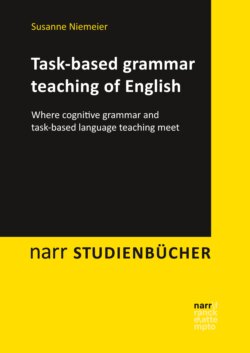Читать книгу Task-based grammar teaching of English - Susanne Niemeier - Страница 23
На сайте Литреса книга снята с продажи.
3.1.2 Lexis-grammar continuum
ОглавлениеThe above-mentioned examples already hint at another of the tenets of cognitive linguistics, namely that it assumes a lexis-grammar continuum and does not see these two areas as opposites. Whereas in generative linguistic a sharp distinction is made between syntax and the lexicon, this distinction is not accepted in cognitive grammar, nor are strict grammatical rules accepted (cf. BROCCIAS 2006: 81). BROCCIAS (2006: 82) describes that in cognitive grammar “syntax and the lexicon form a continuum of constructions ranging from very specific elements (e.g. cat, kick the bucket) to increasingly more general patterns (e.g. nouns, transitive constructions)”. In the cognitive approach, grammar is not seen as consisting of strict rules, but instead as a solution that generations of speakers of a speech community have found to structure their thoughts with the intention of communicating them to other people (cf. RADDEN/DIRVEN 2007: XI).
The same organisational principles apply for lexis as they do for grammar, for example, embodiment, metaphorization, or the notion of boundedness vs. unboundedness. There are countless examples for embodiment in lexis, as human body parts are frequently metaphorically used to designate non-body concepts, as, for example, “foot of the mountain”, “eye of a needle” or “leg of a journey”. An example of embodiment in grammar was already mentioned for the container meaning of in, which can refer to concrete containment (as in “the wine in the bottle”) or to metaphorical containment (as in “caught in a traffic jam”).
In the field of lexis, the notion of boundedness vs. unboundedness1 relates to the distinction between count nouns and mass nouns. Count nouns have a clear contour or boundary and are individualised (such as “cat” or “computer”), i.e., they are bounded, whereas mass nouns refer to non-individualised entities (such as “water” or “salt”) without a clear boundary, i.e., they are unbounded. The same distinction can be found in grammar, as the non-progressive aspect for inherently bounded events (i.e., “he played tennis”) refers to an event with a clear temporal boundary, including the beginning of the event as well as its end, and which is therefore seen as bounded, whereas the progressive aspect for the same verb (i.e., “when I saw him he was playing tennis”) refers to an ongoing event, the boundaries of which are defocused. This event must have begun at some point, but has not yet reached its end when the progressive aspect is used to describe it, and it can therefore be seen as unbounded.
The difference between the two poles of the lexis-grammar continuum is that the principles are evident in a very concrete way when it comes to lexis, but that they are more abstract when it comes to grammar. In the middle of the continuum, where phenomena such as prepositions are to be found, the principles are evident less concretely than for the completely lexical pole and more concretely than for the completely grammatical pole. This difference also relates to the notion of ‘meaningfulness’ – lexical meaning is quite concrete (the word “tree” calls up a very specific mental image of a prototypical tree from the language user’s culture) whereas grammatical meaning is more abstract (using prepositions as an example again, “in my mind” means that the mind is the container of something, usually thoughts or knowledge, whereas “on my mind” means that something is on top of the speaker’s mind, weighing him/her down, and which therefore presumably refers to a problem). Even if speakers do normally not have concrete mental images for prepositions, they are able to perceive the presented situations holistically. The important aspect to underline in this context is again that there IS meaning in grammar, although it is abstract, and that this meaning can be explained to learners.
